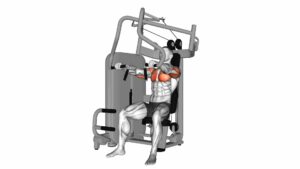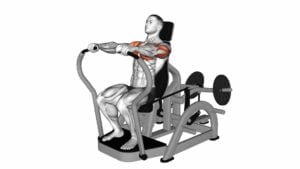Lever Chest Press (VERSION 3) – Video Exercise Guide & Tips

Are you looking to amp up your chest workout?
Watch This Exercise Video
The lever chest press (version 3) is a fantastic exercise to strengthen and tone your chest muscles.
In this video exercise guide, we'll show you the proper technique and provide helpful tips for progression and variation.
Get ready to challenge yourself and achieve your fitness goals with this effective chest press variation.
Let's get started!
Key Takeaways
- Proper equipment setup and body positioning are crucial for performing the lever chest press effectively and safely.
- The lever chest press technique involves pushing the handles forward and fully extending the arms without locking the elbows, then slowly bringing the handles back towards the chest with slightly bent elbows.
- There are alternative exercises such as the barbell bench press, dumbbell chest press, and push-ups that target the same muscle groups as the lever chest press.
- Progression and variation can be achieved by gradually increasing weight, experimenting with different angles and grips, and incorporating progressive overload and variations for continued progress.
Proper Equipment Setup
To properly set up the equipment for the Lever Chest Press (VERSION 3), position yourself on the machine with your feet firmly planted on the ground. Before you begin, make sure all the necessary equipment adjustments have been made. Adjust the seat height so that your feet can comfortably reach the ground and your knees are at a 90-degree angle.
Next, adjust the backrest to align with your upper back, providing adequate support during the exercise. Safety precautions are essential to prevent injury. Ensure that the weight plates are securely attached and that the barbell is locked in place. It's also important to start with a weight that's appropriate for your fitness level and gradually increase it as you progress.
Once you have set up the equipment correctly, you can now focus on correct body positioning, which we'll discuss in the next section.
Transition: Now that you have properly set up the equipment, let's move on to the importance of correct body positioning during the Lever Chest Press (VERSION 3).
Correct Body Positioning
Now that you have properly set up the equipment, let's focus on positioning your body correctly for the Lever Chest Press (VERSION 3).
Proper body positioning is crucial for maximizing the benefits of this exercise and ensuring safety.
The benefits of correct body positioning during the Lever Chest Press are numerous. Firstly, it allows you to target the chest muscles effectively, leading to stronger and more defined pectoral muscles. Additionally, maintaining the correct body position helps to engage the triceps and shoulders, resulting in a more comprehensive upper body workout.
Proper form is of utmost importance in the Lever Chest Press. It ensures that the targeted muscles are properly activated while reducing the risk of injury. By aligning your body correctly, you can generate more power and control during the exercise, leading to improved muscle development.
To achieve the correct body positioning, start by sitting on the machine with your back firmly pressed against the backrest. Your feet should be flat on the floor, shoulder-width apart. Grasp the handles with a firm grip, keeping your elbows at a 90-degree angle. Maintain a neutral spine and avoid arching your back or rounding your shoulders.
Lever Chest Press Technique
Mastering the technique of the Lever Chest Press requires a strong grip and controlled movements. To ensure you perform this exercise correctly, follow these tips:
- Position yourself on the machine with your back flat against the pad and your feet planted firmly on the ground.
- Grip the handles with an overhand grip, keeping your wrists in a neutral position.
- Begin by pushing the handles forward, extending your arms fully without locking your elbows.
- Slowly bring the handles back towards your chest, keeping your elbows slightly bent.
- Maintain a steady and controlled pace throughout the movement, focusing on engaging your chest muscles.
- Keep your core engaged and your back firmly pressed against the pad to maintain stability.
- Remember to breathe continuously throughout the exercise, exhaling as you push the handles forward and inhaling as you bring them back towards your chest.
The Lever Chest Press offers several benefits, including:
- Targeting the chest muscles, specifically the pectoralis major and minor.
- Engaging the triceps and shoulder muscles as secondary movers.
- Providing a more stable and controlled movement compared to free weight exercises.
- Allowing for a greater range of motion, targeting the muscles at different angles.
If you don't have access to a Lever Chest Press machine, here are some alternatives you can try:
- Barbell Bench Press
- Dumbbell Chest Press
- Push-ups
These exercises target the same muscle groups and can be effective alternatives to the Lever Chest Press.
Common Mistakes to Avoid
When performing the Lever Chest Press, it's important to be aware of common mistakes to avoid for optimal results. By avoiding these mistakes, you can ensure that you're targeting the correct muscles and maximizing the effectiveness of the exercise.
One common mistake to avoid is using too much weight. It may be tempting to add on extra weight, but using a weight that's too heavy can lead to improper form and potential injury. It's important to start with a weight that allows you to maintain proper form throughout the exercise.
Another mistake to avoid is arching your back. This can put unnecessary strain on your lower back and take away from the focus on your chest muscles. Keep your back flat against the bench and engage your core to maintain stability.
Additionally, avoid locking out your elbows at the top of the movement. This can cause undue stress on your joints and take away from the muscle engagement in your chest. Instead, maintain a slight bend in your elbows throughout the exercise.
Tips for Progression and Variation
To continue improving your Lever Chest Press, incorporate progressive overload and varying your exercise routine. Here are some progression tips and variation ideas to help you take your workout to the next level:
- Increase the weight: Gradually increase the resistance on the lever chest press machine to challenge your muscles and promote strength gains. Start with a weight that allows you to perform 8-12 reps with proper form and gradually increase the weight as you become stronger.
- Adjust the angle: Experiment with different angles on the lever chest press machine to target different areas of your chest muscles. Try incline, decline, or flat angles to add variety to your routine.
- Change the grip: Altering your grip can engage different muscle groups and add more intensity to your workout. Try using a wider grip to target your outer chest or a narrow grip to focus on your triceps.
By progressively overloading your muscles and incorporating variations into your lever chest press routine, you can continue to challenge your body and see continued progress in your strength and muscle development. Remember to always listen to your body and adjust the intensity and weight accordingly.
Keep pushing yourself and enjoy the results of your hard work!
Frequently Asked Questions
How Many Sets and Repetitions Should I Do for Lever Chest Press to See Results?
To see results with the lever chest press, it's important to focus on the number of sets and repetitions you do. The number of sets and repetitions will depend on your fitness level and goals.
Generally, it's recommended to do 3-5 sets of 8-12 repetitions for muscle growth and strength. However, it's also important to properly perform the lever chest press by maintaining proper form and using the appropriate weight.
Make sure to consult with a fitness professional for personalized guidance.
Can I Perform Lever Chest Press With Dumbbells Instead of a Machine?
Yes, you can perform the lever chest press with dumbbells as an alternative to using a machine. Using dumbbells for chest exercises offers several benefits.
It allows for a greater range of motion, engages more stabilizing muscles, and can help improve muscle symmetry. To perform the exercise, lie on a flat bench and hold a dumbbell in each hand, then press them up and together, focusing on squeezing your chest muscles.
Is It Necessary to Warm up Before Doing Lever Chest Press?
Before performing any exercise, it's important to warm up to prevent injury and maximize the benefits.
Warming up helps increase blood flow to your muscles, making them more pliable and less prone to strains or tears.
It also prepares your body for the workout ahead, improving your performance.
So, yes, it's necessary to warm up before doing the lever chest press.
Remember to take precautions and warm up properly to get the most out of your workout.
What Muscles Does Lever Chest Press Primarily Target?
The lever chest press primarily targets your chest muscles, also known as the pectoral muscles. This exercise is designed to strengthen and tone your chest, giving you a more defined and sculpted upper body.
Can Lever Chest Press Help Improve My Bench Press Strength?
Lever chest press variations can indeed help improve your bench press strength. By incorporating different lever chest press variations into your workout routine, you can target specific muscles that are crucial for bench press performance, such as the chest, triceps, and shoulders.
While the lever chest press may not completely replace the benefits of a barbell bench press, it can be a valuable addition to your training regimen. It can help you build strength and improve your overall bench press performance.
Conclusion
In conclusion, the lever chest press is an effective exercise for strengthening the chest muscles.
By following proper equipment setup and maintaining correct body positioning, you can perform the exercise with optimal technique.
Avoiding common mistakes and gradually progressing with variations will help you achieve better results.
Remember to consult with a fitness professional for personalized guidance and to ensure safety during your workouts.
Keep pushing and enjoy the benefits of a stronger chest!

Author
Years ago, the spark of my life’s passion ignited in my mind the moment I stepped into the local gym for the first time. The inaugural bead of perspiration, the initial endeavor, the very first surge of endorphins, and a sense of pride that washed over me post-workout marked the beginning of my deep-seated interest in strength sports, fitness, and sports nutrition. This very curiosity blossomed rapidly into a profound fascination, propelling me to earn a Master’s degree in Physical Education from the Academy of Physical Education in Krakow, followed by a Sports Manager diploma from the Jagiellonian University. My journey of growth led me to gain more specialized qualifications, such as being a certified personal trainer with a focus on sports dietetics, a lifeguard, and an instructor for wellness and corrective gymnastics. Theoretical knowledge paired seamlessly with practical experience, reinforcing my belief that the transformation of individuals under my guidance was also a reflection of my personal growth. This belief holds true even today. Each day, I strive to push the boundaries and explore new realms. These realms gently elevate me to greater heights. The unique combination of passion for my field and the continuous quest for growth fuels my drive to break new ground.







